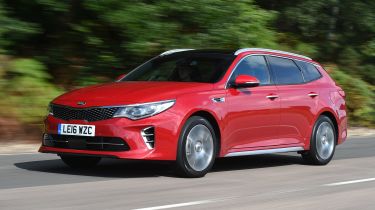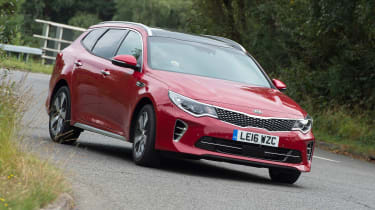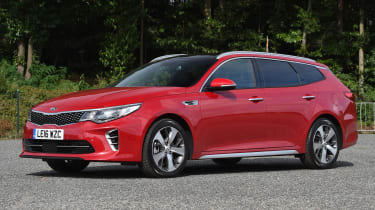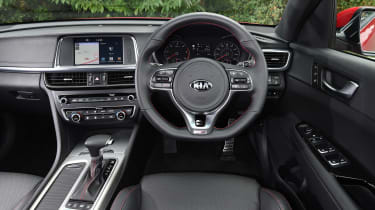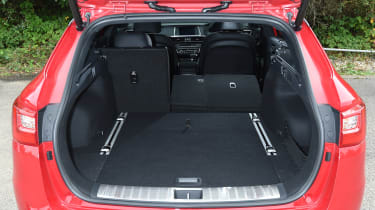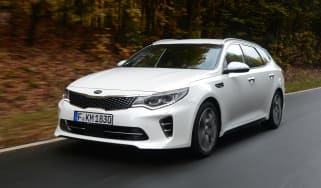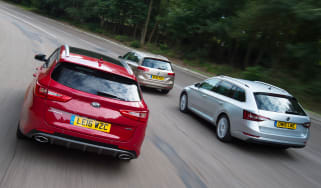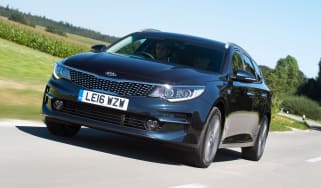Kia Optima Sportswagon review
The Kia Optima Sportswagon estate is practical and stylish, but can it match its rivals?

SUVs have stolen a march on traditional family estates when it comes to hauling around your brood and their luggage. Crossovers tend to offer a little more style alongside their practicality, but plenty of manufacturers are complementing their SUV offerings with sharply designed tourers – and the latest to hit the market is Kia’s Optima Sportswagon.
The large estate car sector is still crowded, and the Optima SW is going up against talented rivals such as the Volkswagen Passat and Skoda Superb estates. The former won the Best Estate Car title at the 2015 Auto Express New Car Awards, but was knocked off the top spot this year by the latter, so the Kia is in a tough segment.
But it has the credentials to push both the Skoda and the VW close, as in top-spec GT-Line S trim it comes with an efficient 1.7-litre turbodiesel engine, hooked up to a dual-clutch automatic gearbox, and plenty of equipment as standard. That diesel engine is fitted to 2, 3 and GT-Line S models, but from early 2017 there will be another engine choice: a 2.0-litre turbo petrol engine with 237bhp (and the potential for even more) in the Optima GT.
Used - available now

2022 Volvo
XC40
20,900 milesAutomaticPetrol2.0L
Cash £26,050
2023 Cupra
Leon
50,524 milesAutomaticPetrol2.0L
Cash £19,900
2019 Vauxhall
Grandland X
54,440 milesAutomaticPetrol1.2L
Cash £10,500
2018 Ford
Kuga
62,719 milesManualDiesel2.0L
Cash £12,400It’s expensive, but the Kia offers a few extra luxuries in GT-Line S trim. The front seats are ventilated as well as heated, while the outer rear seats are also heated, offering even more comfort for those in the back. Wireless mobile phone charging means you don’t have to bother with cables – although there’s a 12-volt socket and a USB port in the rear so back seat passengers can also charge their gadgets.
With good looks, plenty of space and a smart cabin the Kia Optima Sportswagon is worth a look if you’re after a big family car. The Kia is a bit sluggish compared with rivals, and fails to compete on ride quality, but it handles smoother roads well. The rear is roomy, and even the rear seats are heated on top spec models. A Skoda Superb Estate is bigger and a Mazda 6 Tourer is better to drive, but the Kia still offers a good balance of abilities.
Engines, performance and drive
The Kia Optima Sportswagon loses ground to its rivals, the Skoda Superb and VW Passat, in terms of ride quality. The Kia’s suspension set-up doesn’t feel as calm or collected as the Superb’s, even on smooth surfaces. Over bumpy, rippled tarmac the difference is even more noticeable, because the Optima’s body gets jiggled about as the dampers struggle to isolate the movement of the wheels. On motorways the ride is better, but the overly light steering feels at odds with the firmer set-up.
Plus, the weight of the steering doesn’t change as you enter a corner, so while there’s plenty of grip, it’s not relayed to the driver through the wheel. You can still drive the Kia quickly and safely, but under normal conditions, if you’ve got passengers on board, they might not be as comfortable as in the Skoda or Volkswagen. On the plus side, refinement levels are pretty good all-round.
From 2017 onwards, the UK will have the option of a new Optima GT. Following in the footsteps of the smaller Cee’d GT, it gets a more powerful petrol engine and a revised, sportier chassis. It definitely handles better than the standard car, with a greater feeling of agility and more direct steering, while the ride quality isn’t too badly affected. We’d stop short of calling it fun, however.
Engines
Kia’s 1.7-litre diesel is down on power compared with equivalent 2.0-litre engine used by VW Group rivals. And while the 139bhp unit delivers an identical 340Nm torque output at the same 1,750rpm, you have to rev it harder to match the other cars’ acceleration due to the Optima’s heavier 1,635kg kerbweight.
Performance is respectable, but the key alternatives still feel faster on the road. The DCT gearbox manages shifts smoothly, even if it’s not as quick as the VW Group dual-clutch transmission in the Superb and Passat. The manual in lower-spec models is a good one, though, with a smooth action.
The other engine, a 2.0-litre turbo petrol, is a bit of an enigma. Kia will sell it in the Optima GT with 237bhp in Europe, but rumour has it that bosses want it to have more power (possibly up to 280bhp) before it arrives in the UK. As it is, it’s a strong and punchy enough engine, though it’s nowhere near as quick as something like a Skoda Superb 280 4X4. It also gets augmented engine sounds through the speakers, which won't be to all tastes.
MPG, CO2 and Running Costs
Large estates like the Optima Sportswagon make up a significant part of the company car market but while CO2 emissions are competitive, the purchase price will count against the Kia in the eyes fleet buyers. At least there’s a decent amount of standard kit.
The Optima GT-Line S with the DCT automatic gearbox returns 61.4mpg and emits 120g/km of CO2, but for economy the best choice is the manual gearbox car. That model returns 64.2mpg and emits 113g/km, which are decent numbers for a large family car like this.
Official UK figures for the Kia Optima GT are yet to be confirmed, but European figures show it only manages about 34mpg and emits 191g/km of CO2. That’s way behind similarly fast rivals, which is a shame.
Depreciation
While the Kia brand has grown in reputation in leaps and bounds in recent years, the residual values have been slowly improving too. Our used car valuation experts CAP suggest the Optima saloon will retain between 43 and 49 per cent of its new cost after three years and 30,000 miles of motoring, and the estate should match that.
Insurance
Insurance for the Optima will be group 19 for the entry model, and group 20 for the remainder of the line-up. Not quite the cheapest around, as the Ford Mondeo groups start at 17, but it's no more expensive than the Optima saloon.
Interior, design and technology
Like its saloon sibling, the Optima Sportswagon’s lines give it an elegant look. The design remains faithful to the Sportspace concept seen at the Geneva Motor Show in 2015, so the wide grille with Kia’s trademark dip in the middle links the car’s headlights.
The design details have been toned down slightly for the Optima Sportswagon, but the basic shape is similar. A narrow, wide air intake sits beneath the main grille, accentuating the car’s width, while two upright vents at the corners of the front bumper incorporate some silver strakes to differentiate it from the rest of the range, breaking up the bodywork.
The Optima Sportswagon’s wheelarches and shoulder line aren’t as chiseled as the concept’s, but for a production car, the creases running back from the headlights and down its flanks are a nice design detail that give it a solid look. This line rises gently to the tail-lamps, while the window line kicks up and in towards the D-pillar, providing the Kia with strong shoulders and elegant, elongated proportions.
A diffuser-style insert in a contrasting colour to the body houses two oval tailpipes and breaks up the rear bumper and tailgate, while the bright silver roof rails are yet another styling touch that means the Kia cuts an attractive figure on the road. GT-Line and GT models both get sportier styling touches for the exterior, but the overall effect is still pleasingly subtle.
Inside, the styling is a little more subdued. It’s reminiscent of the saloon, so the centre stack features an eight-inch touchscreen above the primary infotainment controls on this GT-Line S model, while the ventilation buttons sit underneath – with the silver accents around the edges of these sections, it looks very similar to a BMW 3 Series.
Material and build quality are solid, while the plastics that cover the dashboard and centre console are soft to touch. However, elsewhere in the cabin the design and feel of the surfaces is not a match for rivals.
Sat-nav, stereo and infotainment
Sat-nav, all-round parking sensors, Bluetooth with voice recognition and Kia’s connected services that work in conjunction with the sat-nav and climate control are standard across the range. GT-Line S also gets a Harman/Kardon stereo, park assist, wireless mobile phone charging, electrically adjustable heated and ventilated leather seats, adaptive cruise and keyless go. In fact, the only option is metallic paint, which costs £545.
Practicality, comfort and boot space
The Optima Sportswagon’s cabin is spacious, but this practical side means it earns its spurs as an estate, with big door bins, two large trays in the centre console, a lidded cubby and divided compartments under the boot floor. A sliding panoramic sunroof makes the cabin feel airy. Details including levers to fold the rear seats remotely make the Optima easy to live with, but its rivals also pack plenty of neat convenience features.
Size
The Kia Optima estate measures up at 4,855mm long, 1,860mm wide, and 1,470mm tall, which is exactly the same as the saloon version, though the roof rails bump the height up slightly.
Leg room, head room & passenger space
There's plenty of rear-seat legroom, and a higher seating position gives the driver better visibility. Seat height adjustment helps to ensure all shapes and sizes can get comfortable. In the back there are the requisite Isofix mounts for child seats. The middle seat in the rear is slightly raised, though it's not too bad and will do for short trips.
Boot space
Estate cars have to offer practicality, which tends to come from a cavernous boot. While the Optima’s 552-litre load bay will be sufficient for day-to-day use, it might not be for a family holiday. It’s down on the Skoda Superb’s 660-litre offering, while the 650-litre VW Passat also serves up more space. It’s a practical space, with a false floor that you can lift up for extra capacity as well as some handy nets either side of the main load area.
Reliability and Safety
Six airbags are standard, and while the Sportswagon hasn’t been tested by Euro NCAP, the Optima saloon was awarded a full five-star crash safety rating. Along with autonomous braking, GT-Line S trim brings blind spot monitoring, rear cross traffic alert, high beam assist and traffic sign recognition. Hi-tech safety features like these are sure to add peace of mind.
Kia as a brand finished 14th overall in our Driver Power 2016 survey, while its garages ranked in the top third of the dealers’ chart, taking ninth spot.
Warranty
With Kia’s seven-year/100,000-mile warranty, there’s peace of mind if you intend to keep the car for more than the usual three years, too, while as the coverage package is transferable, it’ll sweeten the deal if you sell the car before the warranty is up.
Servicing
Kia’s £329 three-year servicing pack is well priced. Its rivals only offer two-service/two-year deals, so the price per check-up on the Optima works out at £110.
